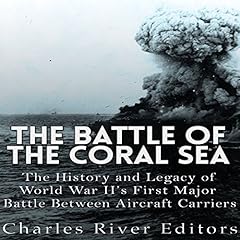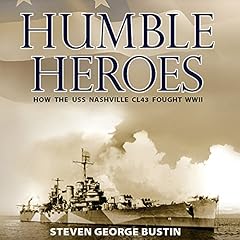
Coral Sea and Midway
The History of the World War II Battles That Turned the Tide in the Pacific Theater
Failed to add items
Add to basket failed.
Add to wishlist failed.
Remove from wishlist failed.
Adding to library failed
Follow podcast failed
Unfollow podcast failed
Buy Now for £6.99
No valid payment method on file.
We are sorry. We are not allowed to sell this product with the selected payment method
-
Narrated by:
-
Ken Teutsch
About this listen
The growing buzz of aircraft engines disturbed the Japanese military construction personnel hauling equipment ashore on the beige coral sand of Tulagi Island at 8:20 AM on May 4th, 1942. Offshore, the large IJN (Imperial Japanese Navy) minelayer Okinoshima, flagship of Admiral Shima Kiyohide, lay at anchor, along with two destroyers, Kikuzuki and Yutsuki, and transport ships. Six Japanese Mitsubishi F1M2 floatplanes also rested on the gentle, deep blue swell, marking Tulagi's future as an IJN floatplane base.
The men on the beach, at inland construction sites, or aboard the Japanese ships, looked up towards the huge white cumulus clouds sailing on the ocean wind. Taken completely by surprise, the Japanese stood and stared as 13 sturdy-looking dive bombers dropped through the cumulus layer at 6,000 feet, plunging towards the IJN ships. As they streaked lower, the white star on a black disc insignia of American aircraft grew visible on the underside of each wing.
This was the beginning of the Battle of the Coral Sea, one that even those fighting it could not know would make history. While the battle is not as well-known as other battles across the Pacific, it set a precedent by pitting enemy aircraft carriers against each other, a battle in which the rival navies themselves never sighted each other or fired a gun at each other. Instead, the fighting was done with the carriers' aircraft, something that would become more common over time and would result in decisive actions at places like Midway just months later. Furthermore, while it was in a sense a tactical victory for the Japanese, it would end up helping blunt their aggressive push east in the Pacific, making it a crucial strategic victory for the Allies.
Although not as well-remembered as D-Day or even the attack at Pearl Harbor that preceded it, the Battle of Midway was one of the most unique and important battles fought during World War II. In fact, the turning point in the Pacific theater took place between June 4-7, 1942 as a Japanese fleet moved a sizable fleet intending to occupy Midway Island and draw the American navy near. Instead, American aircraft flying from three aircraft carriers that had been away from Pearl Harbor in December 1941 got a bearing on the Japanese fleet and sunk four Japanese aircraft carriers, permanently crippling Japan's navy. The Battle of Midway was one of the first major naval battles in history where the enemy fleets never actually saw or came into contact with each other.
By the time the Battle of Midway was over, the defeat was so devastating that it was actually kept secret from all but the highest echelons of the Japanese government. Along with the loss of hundreds of aircraft and over 3,000 men killed, the four Japanese aircraft carriers lost, when compared to America's one lost carrier, was critical considering America's huge shipbuilding superiority. However, the Battle of Midway could also have easily turned out differently. Japan began the battle with more carriers, more and better aircraft, and more experienced crews than the Americans, and if the battle of the Coral Sea was any indication, the two sides had irrefutable proof of the dominance of the aircraft carrier in the Pacific. The implications of earlier clashes were now starkly underlined, and the fighting was now clearly about timing. The carrier fleets were incredibly powerful and crucially important, yet at the same time they were hugely vulnerable weapons systems. The protagonists at Midway were putting into practice a newly emerging naval doctrine, one which ultimately meted out a terrible punishment to the side that miscalculated. Carrier versus carrier combat had come of age.
©2016 Charles River Editors (P)2017 Charles River Editors

















